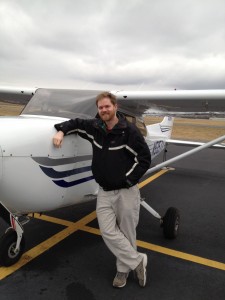My first flight lesson was today. I had a fabulous time.
Getting here required the encouragement of private pilot Anastasia (Pittsburgh, 2003), aerobatic pilot Doug (Hawthorne, 2006), sport pilot Tim (Annapolis, 2011), and co-pilot Evelyn (Boston, 2012). I have long wanted to fly but have long been afraid to start — not because of the flying itself but because of the lifestyle commitment that flying represents. Various pilots and aircraft owners have warned me that flight is a “use it or lose it skill” and that once you start flying you need to keep flying regularly to stay proficient.
But carpe diem, no? I’ve been wanting to do this for a decade, and it’s not like it’s going to become more convenient nor less expensive as more time passes. Evelyn is enthusiastic and exceptionally supportive of the idea of me getting out of the apartment and getting into a cockpit. So, private pilot certificate, here I come.
There are three general aviation airports within reasonable distance of our place: Norwood Memorial (30 minutes southwest), Hanscom Field (35 NW), and Beverly Municipal (40 NE). There are at four different flight schools at these three airports, all of which seem fine at first glance. How to choose? Unfortunately I haven’t met any local pilots yet to get direct recommendations. But one of the schools advertises aerobatic training and aerobatic aircraft as part of their fleet — and thanks to Doug I’m very interested in aerobatics — so earlier this week I scheduled a “discovery flight” with that company to meet the staff, try out the drive to Hanscom, discuss the curriculum and training plan, and get up in the air.
The weather this morning was cold, windy, and overcast, which meant hardly anyone else was using the sky; there were only two other general aviation planes flying near us in the practice area west of the airport. I spent most of the flight grinning from ear to ear. Some of my takeaways:
- The aircraft (at least the Cessna 172SP that we flew today) has metallic wicks on the rear of some of the control surfaces to dissipate any static charge that builds up during the flight. Without the wicks, the buildup of electrical potential could cause communications problems. Neat.
- Full throttle isn’t necessarily better. The concept of “cruise speed” on aircraft has always perplexed me; if the plane can fly faster, why wouldn’t you fly faster in general? Answer: it’s much louder and much less smooth of a ride, not to mention much less fuel efficient.
- I should expect my instructors always to pretend that the GPS is always broken. I’m fairly interested in old-school navigation, be it dead reckoning or the use of VOR/DME equipment, so I was worried that everything would focus on GPS. The instructor assured me that, other than a 30 minute lesson in GPS (“it’s nice to have when the light is fading and you’re lost”), I would get all the old-school navigation I wanted.
- Speaking of dead reckoning: After an hour of having me fly in basically Brownian motion (“ok, now make a steep 180 degree turn keeping your airspeed and altitude fixed but without looking at the instrument panel”) the instructor asked “where’s the airport?” I’m proud to report that my guess was only off by 90 degrees (I said “east”, the correct answer was “north”).
Most flight schools appear to offer a discovery flight of 30 or 60 minutes (today’s was 60 minutes of flight time as part of an overall 150-minute lesson, including the pre-flight briefing and weather analysis, pre-flight inspection, and post-flight briefing, for $200). In a discovery flight the student gets to perform the takeoff (yay!) and most of the flying, with hands-on practice in basic aircraft handling: roll/pitch/yaw, trim for level flight, coordinated turns, slow flight, and visual references. I started lessons today thanks to the discovery flight that Anastasia gifted me a decade ago, plus the ongoing encouragement I’ve received from my friends and family: Thank you.
